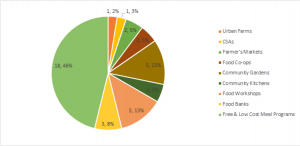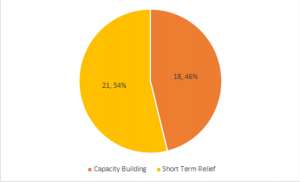Introduction
We’re back! This is our last blog update as our Community-Based Experiential Learning project is approaching its end. Since our last post, we have verified the resources listed in the old food resource guide give to us by GNH and have also added more available food resources. We are beginning to focus our efforts on the possible presentation formats for a new guide. We have also written our executive summary for our final report! We’ve provided it in this blog and it also serves as a recap as to what we have done during this project, why it is important and what we can do with the information we have found.
Executive Summary
Gordon Neighbourhood House (GNH) provides a variety of services to the West End neighbourhood located in downtown Vancouver. They have several food-related programs available to their members and see the value in food beyond its nutritional capacity—its ability to connect individuals and strengthen communities. In this project we worked with GNH on their Community Food Resource Guide. Their current guide is out-of-date and they have indicated that they would like to incorporate food resources available to the community beyond those geared toward short term relief. GNH has also asked us to look into potential ways the food guide might be presented to the public. As we investigate these resources, we hope to gain insight into the status of community food security in the neighbourhood.
Community food security has both short term and long term components that eventually contribute to the sustainability of the global food system. Traditionally, food security has focused on the short term needs of hungry individuals but has largely ignored the long term components that give a community autonomy over its food security. Our goal was to focus on the capacity of the building food-related assets of the West End and adjacent neighbourhoods in this project. This approach, referred to as “asset-based community development”, relies on the social capital present within communities to internally drive lasting impacts instead of relying on outside experts to create meaningful change.
While our project focused on finding the food-related assets of the West End community, we were unable to find many capacity-building food resources. It is possible that these resources are scarce in the West End or just difficult to source. However, we suggest future projects focus on working more directly with community members to “asset-map” the West End food resources. This may paint a more complete picture of the food resources available and overall community food security in the West End since it would include resources from non-traditional and more informal sources. Additionally, it may help generate enthusiasm that would help transform the Community Food Resource Guide into a self-sustaining document.
Project Challenges
What?
Or first objective for this project was to update and expand GNH’s current Community Food Resource Guide. Now having completed this objective to the best of our abilities, we have moved on to our second objective of identifying potential user-friendly formats for the final presentation of the guide. Since we are not experts on creating successful resource guides, we found ourselves wondering, “What makes a good resource guide?” and “Are there any previous projects that will serve as a model?”
The biggest challenge now, then, is the time crunch we have as we approach the final days of the semester and the thus, the project. Beginning our resource hunt took longer than anticipated and so we find ourselves now with less time to answer these important questions.
So What?
To make the guide more user-friendly, it needs to become usable by both professionals (e.g. staff at GNH) as well as the general public (e.g. GNH members). The ultimate goal for GNH is to create a guide that would become self-sustaining, and so we would like our project to facilitate this goal. Another overarching goal of GNH and its Guide is to positively contribute to the long term food security of the West End community. Finding a way to present this information thus will have implications in the ability of the guide to facilitate the goals of GNH. If the resource guide does not have up-to-date information will become irrelevant, and so the long term success of the guide will become compromised and its ability to contribute to West End food security.
Now What?
At the beginning of the project we brainstormed different ways the guide might be presented. The project outline suggested a web-based or print-based format (i.e. a brochure). Since the information in the guide will need to be updated often, sometimes even on a weekly basis (for example, with food workshops), our group decided that a formal print-based format may not mesh well with the contents of the guide. We discussed a wiki format–so that the guide may have the benefit of collaboration from more than just “expert” sources, such as ourselves, to more participation from community members as well. This aligns with the Asset-Based Community Development (ABCD) model that we have explored in class. The ABCD model works on the premise that needs-based projects and help create dependency, where as focusing on the assets of a community can inspire internally-driven change and participation from the community (Mathie & Cunningham, 2003). We may not have time to explore other presentation mediums that might suit this project. So to overcome the challenge of our end-of-semester time crunch, we will just explore the feasibility of the wiki-based guide.
Sneak Peek: Results
For our methods in collecting our food resources, we divided these resources into different categories: urban farms, CSAs, farmer’s markets, food cooperatives, community gardens, community kitchens, food workshops, food banks, and free or low-cost meal programs (fig. 1), and the organization types can be categorized as capacity-building or short term relief programs (fig. 2). Capacity-building programs add to the long-term sustainability of a local food system by building community knowledge and skills needed for self-management in that community. Short term relief programs, on the other hand, are important programs needed to address the immediate hunger needs of vulnerable individuals in the population (VCH, 2011). In our project, food banks and free or low-cost meal programs are short-term relief, whereas the other seven resource types can be considered capacity-building programs. The results we found showed the majority of the resources that we found were short term relief (54%), with Meal Programs being the largest resource within the short term relief category. These types of programs were the easiest to find as they were often advertised or referenced to online.

Figure 1. A pie chart that shows the distribution of resource types we found over nine different categories.

Figure 2. A pie chart showing the distribution of Capacity-Building versus Short Term Relief programs that we found.
This was a small sneak peek into the results of our project. You will have to wait until our final report in order to see how we have interpreted these findings! Wish us luck as we find ourselves nearing the end of our project!
Group 15
References
Mathie, A., & Cunningham, G. (2003). From clients to citizens: Asset-based Community Development as a strategy for community-driven development. Development in Practice, 13(5), 474–486.
Vancouver Coastal Health. (2011). Vancouver Coastal Health Community Food Action Initiative: Evaluation Report. Burnaby, BC: Social Planning and Research Council of British Columbia and Tony Beck.